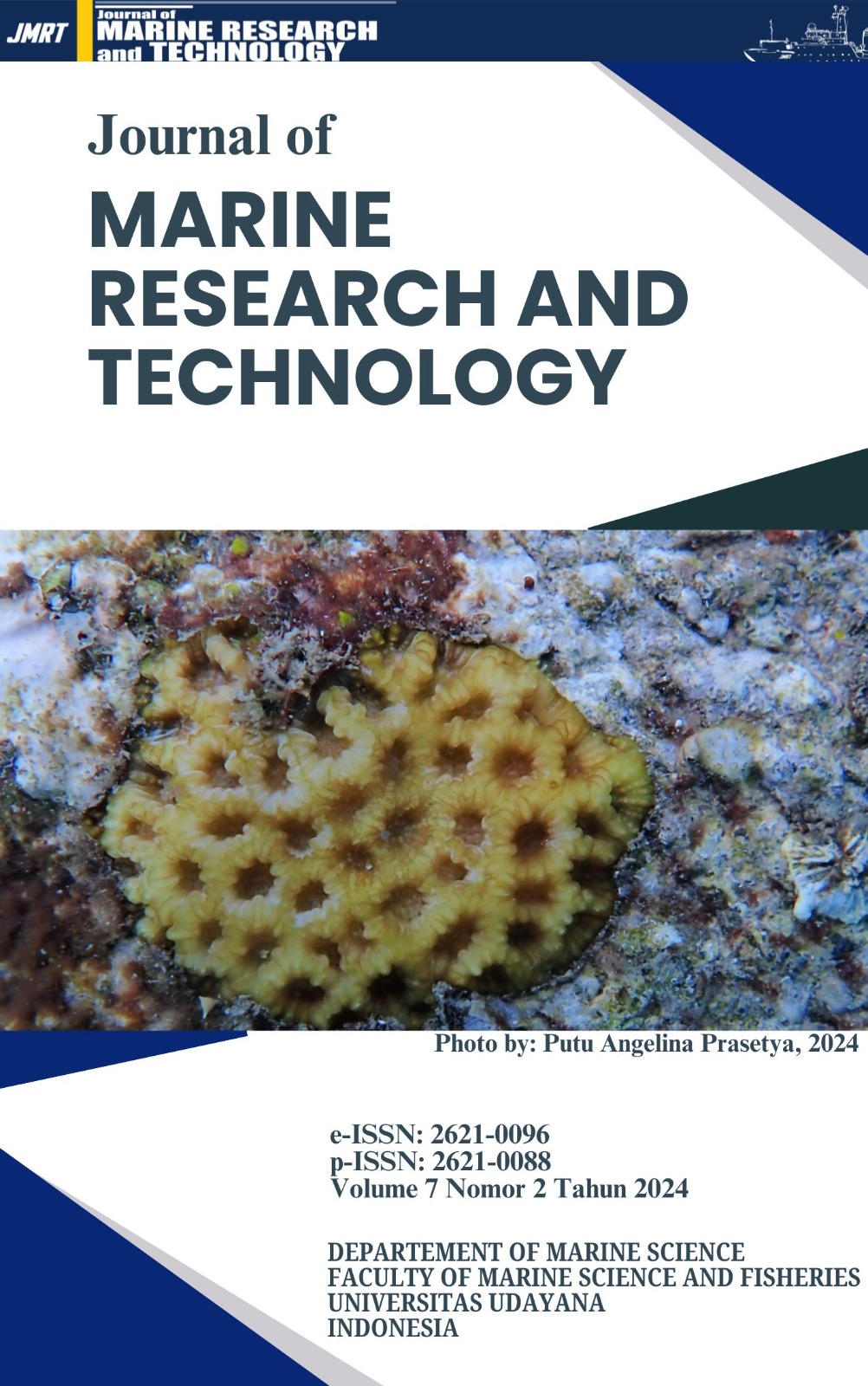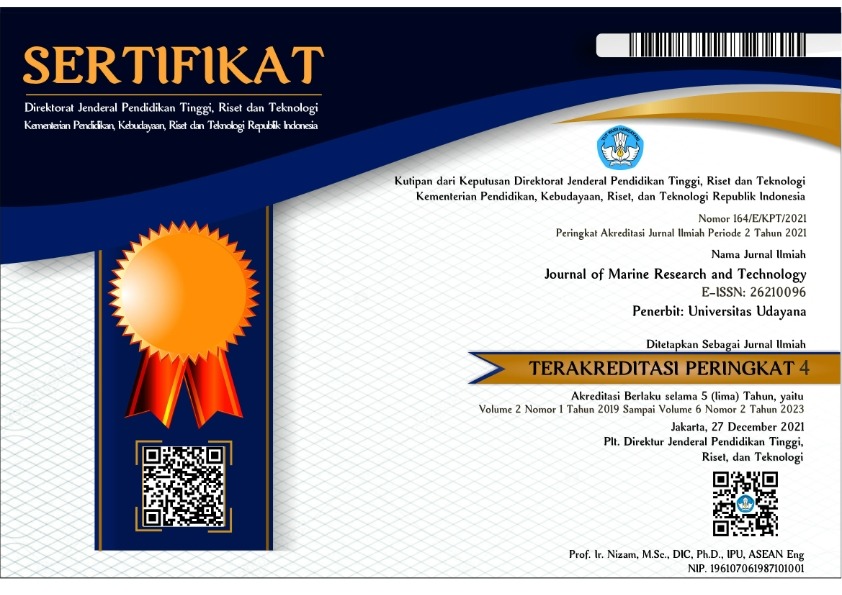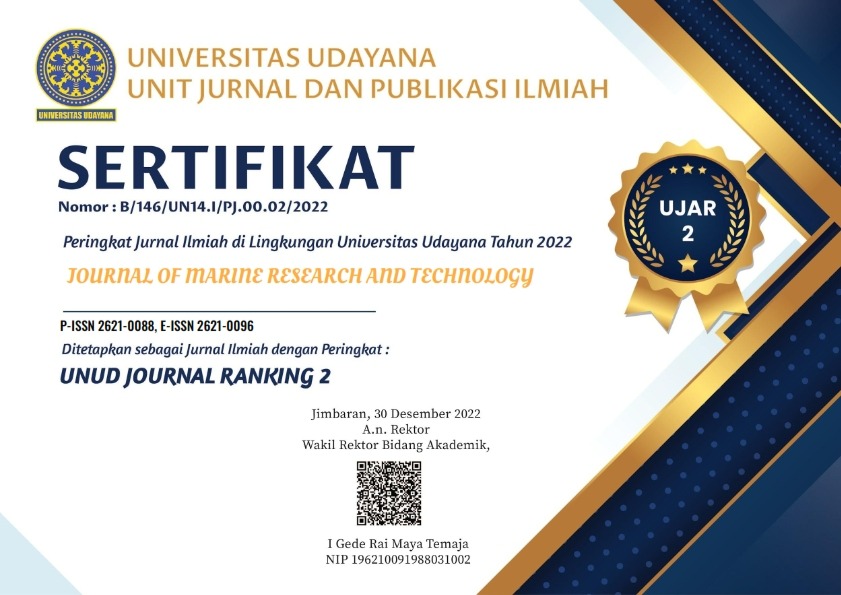Identifikasi Jenis dan Kepadatan Mikroplastik pada Sedimen Mangrove di Kawasan Estuari Perancak Kabupaten Jembrana, Bali
Mangrove; Microplastic; Generalized Additive Model; Marine Debris
Abstract
Waste is a problem for communities all over the world. Microplastics are found in the environment, mangrove beach sediments, and worldwide oceans. Microplastics are plastic particles measuring <5 mm. The Perancak mangrove forest area, Jembrana Regency, Bali, is an estuary area with complex activities, namely tourism, fishing, and residential. This research aimed to determine the type and density of microplastics in mangrove sediments using cluster analysis of residential areas in large and small rivers. The method used is simple random sampling with 10 points in each cluster. The sampling method uses a pipe with a diameter of 7.5 cm, a depth of 20 cm. Sediment sample processing used the Masura method, 2015, and density calculations used the NOAA 2013 formula. The number of microplastics found was 517 particles. Population clusters had 101 particles, large rivers had 103 particles, and small rivers had 313 particles. The types of microplastics found were 213 particles in film, 28 particles in fragments, 46 particles in fiber, and 230 particles in foam. Microplastic density calculations yielded 30.21 particles/kg in the Residential Cluster, 34.11 particles/kg in the large river Cluster, and 95.07 particles/kg in the small river Cluster. Model testing using the GAM Generalized Additive Models model) with the lowest AIC value shows that small river and residential clusters significantly influence microplastic particles. In contrast, large river clusters are not significant. There is no significant effect on the number of microplastic particles at residential points and tourist points because the rice field points significantly influence the number of microplastic particles.
Downloads
References
Jambeck, J.R., R. Geyer, C. Wilcox, T.R. Siegler, M. Perryman, A. Andrady, R. Narayan, K.L. Law. 2015. Plastic waste inputs from land into the ocean.Science Vol. 347, ISSUE 6223
Jupriyati, R., N. Soenardjo, dan C. A. Suryono. 2013. Akumulasi Logam Berat Timbal (Pb) dan Pengaruhnya Terhadap Histologi Akar Mangrove Avicennia marina (Forssk). Vierh. di Perairan Mangunharjo Semarang. Journal of Marine Research. 3 (1): 61-68.
Kementerian Lingkungan Hidup dan Kehutanan. (n.d). Sistem Informasi Pengelolaan Sampah Nasional. Diakses tanggal 17 April 2021, dari http://sipsn.menlhk.go.id/sipsn/#
Munandar, M., & Kusumawati, I. (2017). Studi analisis faktor penyebab dan penanganan abrasi pantai di wilayah Pesisir Aceh Barat. Jurnal Perikanan Tropis, 4(1), 47-56.
NOAA [National Oceanic and Atmospheric Administration]. 2013. Programmatic Environmental Assessment (PEA) for the NOAA Marine Debris Program (MDP). NOAA. Maryland (US).
Nor, N.H.M. and Obbard, J.P., 2014, Microplastics in Singapore Coastal Mangrove Ecosystems, J. Mar. Pollut. Bull., 79(1-2): 278-283
Septian, F. M., Purba, N. P., Agung, M. U. K., Yuliadi, L. P.S., Akuan, L. F., & Mulyani, P. G. (2018). Sebaran Spasial Mikroplastik di Sedimen Pantai Pangandaraan, Jawa Barat. Jurnal Geomaritim Indonesia, 1(1): 1–8.
Strand J, Pia L, Yvonne S, Jesper HA. 2013. Microplastic particles in sediments from Danish waters. ICES Annual Science Conference.
Susiana. 2015. Diversitas dan Kerapatan Mangrove, Gastropoda dan Bivalvia di Estuari Perancak, Bali. Makassar : Program Pascasarjana, Universitas Hasanuddin, 2011. Vol. Tesis.
Watters, D.L., Yoklavich A Rocha International. (2018). Guidelines for Sampling Microplastics on Sandy Beaches. 1–41.
Aruna. 2017. Sampah Laut, Ancaman Nyata Ekosistem Laut. https://aruna.id/2017/05/12/sampah-laut- ancaman-nyata-ekosistem-laut/. [20 November 2017].
Castillo, A. B., Al-Maslamani, I., & Obbard, J. P. (2016). Prevalence of microplastics in the marine waters of Qatar. Marine Pollution Bulletin, 111(1–2), 260–267. https://doi.org/10.1016/j.marpolbul .2016.06.108
Citrasari, N., N.I. Oktavitri, A. Nuril, & Aniwindira. (2012). Analisis laju timbunan dan komposisi sampah di permukiman pesisir Kenjeran Surabaya. J. Biol. Res., 18, 83–85.
Cordova, M. R., Purwiyanto, A. I. S., & Suteja, Y. (2019). Abundance and characteristics of microplastics in the northern coastal waters of Surabaya, Indonesia. Marine Pollution Bulletin, 142(October 2018), 183–188. https://doi.org/10.1016/j.marpolbul .2019.03.040
Frias, J. P. G. L., Otero, V., & Sobral, P. (2014). Evidence of microplastics in samples of zooplankton from Portuguese coastal waters.
Ghozali, I. (2016) Aplikasi Analisis Multivariete Dengan Program IBM SPSS 23. Edisi 8. Semarang: Badan Penerbit Universitas Diponegoro.
Jambeck, J.R., R. Geyer, C. Wilcox, T.R. Siegler, M. Perryman, A. Andrady, R. Narayan, K.L. Law. 2015. Plastic waste inputs from land into the ocean.Science Vol. 347, ISSUE 6223
Jupriyati, R., N. Soenardjo, dan C. A. Suryono. 2013. Akumulasi Logam Berat Timbal (Pb) dan Pengaruhnya Terhadap Histologi Akar Mangrove Avicennia marina (Forssk). Vierh. di Perairan Mangunharjo Semarang. Journal of Marine Research. 3 (1): 61-68.
Kartikasari, Afrinda D., & Sukojo, B. M. (2015). Analisis Persebaran EkosisternHutan Mangrove menggunakan Citra Landsat-8 di Estuari Perancak Bali. JurnalGEOID, 11(01), 1-8
Kartikasari, Afrinda D., & Sukojo, B. M. (2015). Analisis Persebaran Ekosistern Hutan Mangrove menggunakan Citra Landsat-8 di Estuari Perancak Bali. JurnalGEOID, 11(01), 1-8
Kementerian Lingkungan Hidup dan Kehutanan. (n.d). Sistem Informasi Pengelolaan Sampah Nasional. Diakses tanggal 17 April 2021, dari http://sipsn.menlhk.go.id/sipsn/#
Kuasa S. 2018. Keberadaan Mikroplastik pada Hewa Filter feeder di padang lamun kePulauan Spermonde kota Makasar. Skripsi. Makasar. UHM
Martini, R. S., Bahri, Z., & Miranda, A. T. (2020). PENGARUH DEBIT ALIRAN TERHADAP SEDIMENTASI DI SUNGAI LEMATANG KABUPATEN LAHAT. Bearing: Jurnal Penelitian dan Kajian Teknik Sipil, 6(3), 188-193
Masura, J., Baker, J., Foster, G., & Arthur, C. (2015). Laboratory Methods for the Analysis of Microplastics in the Marine Environment: Recommendations for quantifying synthetic particles in waters and sediments.
Matdoan, M. Y., & Van Delsen, M. S. N. (2020). Penerapan Analisis Cluster Dengan Metode Hierarki Untuk Klasifikasi Kabupaten/Kota Di Provinsi Maluku Berdasarkan Indikator Indeks Pembangunan Manusia. Statmat: Jurnal Statistika Dan Matematika, 2(2), 123-130.
Munandar, M., & Kusumawati, I. (2017). Studi analisis faktor penyebab dan penanganan abrasi pantai di wilayah Pesisir Aceh Barat. Jurnal Perikanan Tropis, 4(1), 47-56.
NOAA [National Oceanic and Atmospheric Administration]. 2013. Programmatic Environmental Assessment (PEA) for the NOAA Marine Debris Program (MDP). NOAA. Maryland (US).
Nor, N.H.M. and Obbard, J.P., 2014, Microplastics in Singapore Coastal Mangrove Ecosystems, J. Mar. Pollut. Bull., 79(1-2): 278-283
Sekaran, U. & Bougie, R.J., (2016). Research Methods for Business: A skill Building Approach. 7th Edition, John Wiley & Sons Inc. New York, US.
Septian, F. M., Purba, N. P., Agung, M. U. K., Yuliadi, L. P.S., Akuan, L. F., & Mulyani, P. G. (2018). Sebaran Spasial Mikroplastik di Sedimen Pantai Pangandaraan, Jawa Barat. Jurnal Geomaritim Indonesia, 1(1): 1–8.
Sidik, F., A. Yunanto, N. Widagti, Y. Pancawati, A.W. Hastuti, N.A. Pradisty, H.P. Kadarisman, M.A. Rahman, I.N. Surana, A. Muslim. 2015. “Aplikasi Sistem Observasi Adaptasi Mangrove terhadap Perubahan Iklim”, BPOL, Bali
Strand J, Pia L, Yvonne S, Jesper HA. 2013. Microplastic particles in sediments from Danish waters. ICES Annual Science Conference.
Susiana. 2015. Diversitas dan Kerapatan Mangrove, Gastropoda dan Bivalvia di Estuari Perancak, Bali. Makassar : Program Pascasarjana, Universitas Hasanuddin, 2011. Vol. Tesis.
Watters, D.L., Yoklavich M.M, Love M.S, & Schroeder, D.M. 2010. Assessing Marine Debris in Deep Seafloor Habitats off California. Marine Pollution Bulletin, 60:131-138
Watters, D.L., Yoklavich M.M, Love M.S, & Schroeder, D.M. 2010. Assessing Marine Debris in Deep Seafloor Habitats off California. Marine Pollution Bulletin, 60:131-138.
Widinarko dan Inneke. 2018. Mikroplastik dalam seafood dari pantai Utara Jawa.Unika . Semarang. Soegijapranata. ISBN 978-602-6865-74-8
Widyadhana, et al., (2021). Perbandingan Analisis Klaster K-Means dan Average Linkage untuk Pengklasteran Kemiskinan di Provinsi Jawa Tengah. PRISMA, Prosiding Seminar Nasional Matematika, 4(2021), 584-594.
Wright, S. L., Thompson, R. C., & Galloway, T. S. (2013). The physical impacts of microplastics on marine organisms: A review. Environmental
Yunanto, A. (2021). KARAKTERISTIK MIKROPLASTIK PADA EKOSISTEM PESISIR DI KAWASAN MANGROVE PERANCAK, BALI. JFMR (Journal of Fisheries and Marine Research), 5(2), 436-444.
Zhou, Q., Tu, C., Fu, C., Li, Y., Zhang, H., Xiong, K., ... & Luo, Y. (2020). Characteristics and distribution of microplastics in the coastal mangrove sediments of China. Science of the Total Environment, 703, 134807M.M, Love M.S, & Schroeder, D.M. 2010. Assessing Marine Debris in Deep Seafloor Habitats off California. Marine Pollution Bulletin, 60:131-138
Widyadhan, D., Hastuti, R. B., Kharisudin, I., & Fauzi, F. 2021. Perbandingan analisis klaster k-means dan average linkage untuk pengklasteran kemiskinan di provinsi jawa tengah. In PRISMA, Prosiding Seminar Nasional Matematika (Vol. 4, pp. 584-594).
Wright, S. L., Thompson, R. C., & Galloway, T. S. (2013). The physical impacts of microplastics on marine organisms: A review. Environmental
Yunanto, A. (2021). KARAKTERISTIK MIKROPLASTIK PADA EKOSISTEM PESISIR DI KAWASAN MANGROVE PERANCAK, BALI. JFMR (Journal of Fisheries and Marine Research), 5(2), 436-444
Copyright Notice
The copyright to this article is transferred to Journal of Marine Research and Technology (JMRT). The copyright transfer covers the exclusive right and license to reproduce, publish, distribute and archive the article in all forms and media of expression now known or developed in the future, including reprints, translations, photographic reproductions, microform, electronic form (offline, online) or any other reproductions of similar nature.






